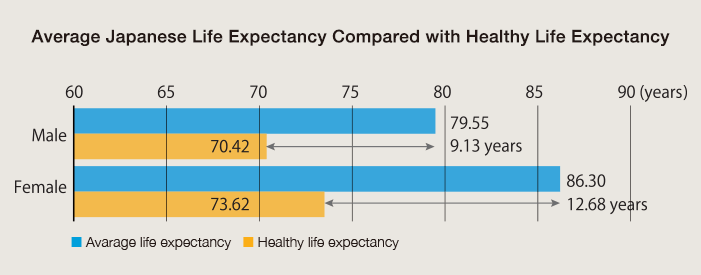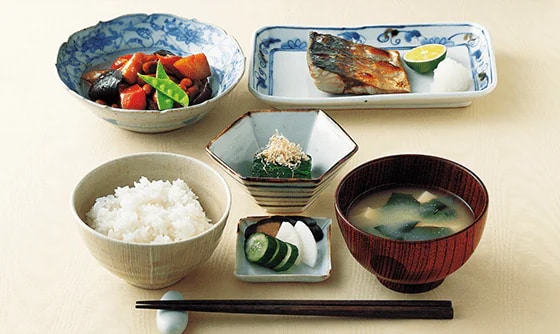
The Secret of Longevity in Japan
Washoku traditional Japanese cuisine has a significant correlation to overall health and quality of life. Our current Feature series considers this relationship from a medical perspective, in terms of nutrition and how washoku influences longevity. Shizuoka Prefecture, whose specialties include green tea and citrus unshiu, has the highest healthy life expectancy in Japan.
by Yukio Yamori
People age as their blood vessels age, and longevity is low in those regions where strokes and heart attacks—the two major vascular diseases—are common. Compared with stroke, heart attacks occur among relatively younger people; and World Health Organization (WHO) statistics indicate reduced longevity in those advanced countries where heart attack figures are high. The reason that Japan continues to show the highest rates of longevity is that, among developed countries, it has the lowest death rate from heart attack among all age groups.
Relating Diet to Health
The Cardiovascular Diseases and Alimentary Comparison (CARDIAC) study which I launched in 1985 sought data on the causes of cardiovascular disease through the collection of blood samples and 24-hour urine samples, in order to examine the relationship of diet to health. Heart attacks occur because, when levels of cholesterol in the blood are high, the blood vessels that nourish the heart are narrowed owing to arteriosclerosis, which results in a reduced supply of blood to the heart. Among countries in which rice is the staple diet, calorie intake from fat is low, thus cholesterol in the blood is low and heart attacks are fewer. Those who are overweight are vulnerable to heart attacks, but obesity is less of a problem in rice-consuming areas, where the intake of calorie-rich fats is low. When people eat rice, the blood-sugar level rises gradually and the insulin needed to regulate blood-sugar levels elevates slowly. This attenuates the production of fat in the body; therefore, instances of obesity are fewer.

good nutritional balance in mind.
We also found from our analysis of 24-hour urine samples that the risk of heart attack was lower with diets rich in taurine, a kind of amino acid abundant in fish and shellfish, and that heart attacks were fewer when the blood had a plentiful supply of fatty acids such as DHA from fish oil. Taurine is good for the heart, as it acts to lower both cholesterol and blood pressure. The fatty acids in fish promote good blood circulation and can thus protect the heart from heart attacks. We further noted that those with a high intake of grains, beans, seaweed products and vegetables loaded with magnesium are less likely to suffer from obesity, high blood pressure and excess cholesterol in the blood, and are therefore less likely to have heart attacks.
Taurine and Magnesium
Taurine is plentiful in seafood and some seaweeds, and magnesium, also found in seaweeds, is in ample supply in beans, grains, seeds, nuts and other land-based products. In Fukui Prefecture, known for its archeological excavations, well-preserved kitchen middens have been uncovered, and these tell us much about the diet of people of the Jomon era (10,500BC– ca. 300BC) who lived there some 5,500 years ago. They obtained magnesium from seeds and nuts, including acorns and walnuts, and taurine from fish, shellfish and wild game. From their first appearance in Africa more than 2,000,000 years ago until the advent of agriculture not more than 10,000 years ago, human beings flourished and evolved for millennia, thanks to these two major sources of nourishment. Japanese have achieved low levels of heart attacks, and thus the highest rates of longevity in the world, because of their ricebased diet and the wealth of taurine and magnesium obtained from the bounty of both sea and land: fish, soybeans, vegetables and seaweed.
Healthy Life Expectancy
Globally, the average lifespan is longest among Japanese; but their healthy life expectancy* is actually 10 years less than the average lifespan in general. Japanese experience high numbers of stroke and bone fractures, both of which cause patients to become bedridden. The main cause of stroke is high blood pressure; in the CARDIAC survey, it was found that the higher the salt intake, the higher the blood pressure, and thus the greater incidence of stroke. High levels of potassium, which counteracts the detrimental effects of salt, are found in fruit and vegetables, but most people do not consume enough of these to be effective. The incidence of stroke is higher when the proportion of sodium (the main component of salt) to potassium is greater. Today, the healthy life expectancy in Japan is highest in Shizuoka Prefecture, where considerable amounts of green tea (with its high levels of potassium and antioxidants) are consumed, and where citrus unshiu and other fruit and vegetables are an important part of the diet. In our international study, we found that the proportion of sodium to potassium in those living in Shizuoka was the lowest among all the advanced nations for which there were statistics on stroke. Another factor to take into account is bone fracture. Bones become brittle as the result of calcium loss, or osteoporosis, and among Japanese not traditionally in the habit of consuming dairy products, there is a tendency for calcium deficiency. Excess salt intake, furthermore, leads to loss of calcium.

The longevity that Japanese enjoy today is without doubt owing to the washoku diet, which is well-suited to human development in that it has provided a balanced range of foods from both land and sea since the Jomon era: rice, beans, fish, vegetables and seaweeds. If the two significant weaknesses of this diet—excess sodium intake and chronic calcium shortage—could be overcome, then it would be more likely that we could prevent patient health from deteriorating prematurely through bedridden disabilities from stroke and bone breakage caused by osteoporosis. Then we would have a true chance for improved healthy life expectancy alongside greater longevity.
- *Years an individual may live without limitations on daily activities owing to health problems.















